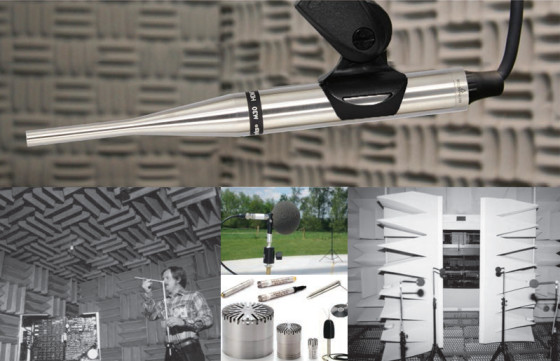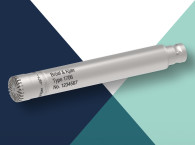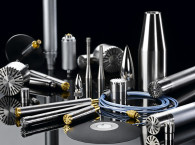Measurement microphone pricing varies greatly from $10 to 4,000. The quality differs immensely and there are many choices in between. The low-cost measurement microphones’ saving graces are they have smoother responses and more extended top-ends than just about any speaker you will test (i.e., if you measure distortion at 1m at 1W, the distortion is likely to be well below the test speaker).

Condenser VS. Self-Polarizing Back Electret Measurement Microphones
A measurement microphone is really a pressure microphone, responding to sound pressure without regard to directionality. Of course, physical reality has to be considered and the pressure mic’s diameter must be small enough that diffraction and wavelength effects do not interfere with accurate measurements. Standard measurements are 0.5”, 0.25”, and 0.125”. There are many large studio microphones with capsules and housings at 1” diameter and larger. While these can record some aesthetically pleasing sounds, they are not appropriate for measurement microphone uses. The large diameter, along with other factors, contributes to poor microphone performance past 8 kHz. However, there are more measurement microphones used for recording than there are ones used for measuring speakers.
Free-Field, Diffuse-Field, & Pressure Microphones
The type of measurement — free, diffuse, or pressure-field - really doesn’t matter if you use a mid-priced measurement microphone with a ±2-dB accuracy for recording or field measurements (e.g., EQing a sound system below 16 kHz). A free field is a sound field where the sound waves are free to expand outward from the source without reflections or reverberation. An anechoic chamber can be considered a free field or an outdoor measurement, provided the measurement is done at a sufficient distance from the ground.
A diffuse field or a random incidence field is a sound field where the sound waves arrive equally from all directions.
Another way to think of a diffuse field is that there are sounds coming from different directions in succession with no time in between their arrival. A pressure field is a sound field where the sound pressure has the same magnitude and phase at any position in the sound field.
The differences among the three types of microphones occur at higher frequencies and depend on the microphone’s diameter. Measurement microphones are designed to respond to a uniform frequency response to the sound level itself.
Measurement microphones are designated as a “Type” or “Class,” (i.e., Type 1, 2, or 3). There is no type or class for microphones themselves, but rather their precision to meet Type 1 (or 2) as used in a sound level meter. Still, it is common usage to grade measurement microphones’s precision and stability this way.
The sound level meter’s type or class is described as its accuracy defined by the relevant international standards (e.g., Type 1 is more accurate than Type 2). The American National Standards Institute (ANSI) S1.4 and an older International Electrotechnical Commission (IEC) standard 60651 referred to the grade as “Type,” but the new IEC standard 61672 refers to it as “Class.” Although these standards have similarities, the later standard makes more demands on the meter regarding accuracy, performance, and calibration. Stability over time and temperature are also considerations. You would expect B&K, G.R.A.S., or ACO Pacific type measurement microphones to meet the Type 1 standard. Field measurement microphones and sound level meters (e.g., electret condenser microphone (ECM) capsule types) mostly meet Type 2 standards. Low-cost sound-level meters (e.g., Radio Shack analog units) are considered Type 3 because they can be a bit off for frequencies above 1 kHz since they only need to be accurate for A and C-weighted sound-level work.
A few low-cost “measurement” ECMs are simply commodity-grade 8-mm mic capsules in a tube. ECM capsules’ signal-to-noise ratios can be below 56 dB to above 62 dB. This will impact the noise and distortion floor you can measure. ECM capsules can be “treated” to help stabilize sensitivity shift with temperature or by integrating an application-specific integrated circuit (ASIC) available from Fairchild Semiconductor. The pre-amp can compensate for this. Yet, it is not fair to group all electret condenser measurement mics together. Panasonic has a popular 8-mm capsule often used in low-cost measurement microphones. However, there are better and worse ECMs that can be used for entry-level measurement microphones. The Panasonic is a back electret and is relatively flat, but 10 dB or more noisier than lab-grade instruments with more variations on temperature and time.
Size Matters
Measurement microphones are pressure microphones that ideally have an omnidirectional pick-up pattern. In the real world, the microphone diameter determines the highest frequency a microphone can measure before directional effects and resonances kick in. Microphones range from diameters of 1”, 0.5”, 0.25”, and 0.125”.
On the other hand, a lower cost ECM-based 0.5” tip diameter measurement microphone diaphragm can use a 10-mm capsule and achieve 70 dB signal-to-noise and better than 125 dB maximum sound level at the expense of some predictable anomalies at the top end. When designing microphone capsules there are some tradeoffs between extended top-end response and signal to noise. Why would you need your measurement mic to handle high SPL? Well, you could be in a “sound off” autosound contest, but more serious applications include close-in nearfield measurements on woofers at low frequencies. I have seen some low-cost measurement microphones and sound-level meters that use nonstandard diameters and the less expensive cost does not include the cost of a hammer to fit it into a calibrator.
Measurement Microphone Calibration
To take a scientific (or legal) measurement with a microphone, its precise sensitivity must be known in volts per Pascal. Since this may change over the device’s lifetime, especially with electret condenser types, it is necessary to regularly calibrate measurement microphones. This service is offered by some microphone manufacturers and by independently certified testing labs. All microphone calibrations are traceable to primary standards at a National Measurement Institute (e.g., the National Physical Laboratory in the UK, PTB in Germany, and NIST in the US) where the reciprocity calibration is the internationally recognized means of realizing the primary standard. Laboratory-standard microphones calibrated using this method are used to calibrate other microphones through comparison calibration techniques (i.e., secondary calibration), referencing the output of the “test” microphone against the reference laboratory standard microphone’s output.
A microphone’s sensitivity varies with frequency and other factors (e.g., environmental conditions such as temperature and humidity) and is normally recorded as several sensitivity values, each for a specific frequency band. A microphone’s sensitivity can also depend on the sound field’s nature. For this reason, microphones are often calibrated in more than one sound field, (e.g., a pressure field and a free field).
Depending on their applications, measurement microphones must be tested periodically and after any potentially damaging event (e.g., being dropped or exposed to excessive sounds levels beyond the device’s operational range). ECMs are more likely to need frequent calibration compared to “true condenser” measurement microphones.






